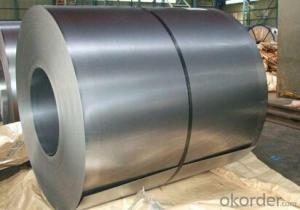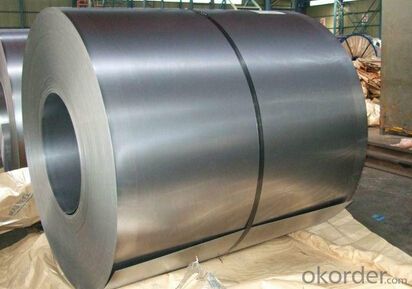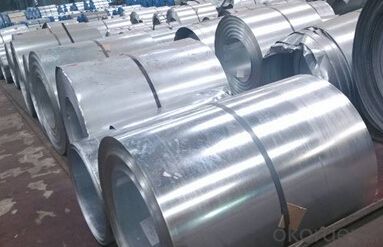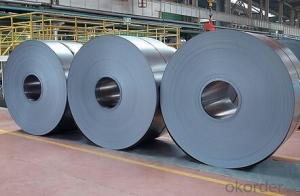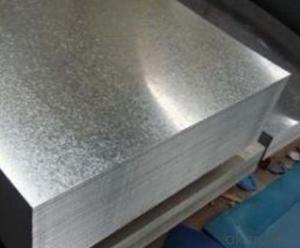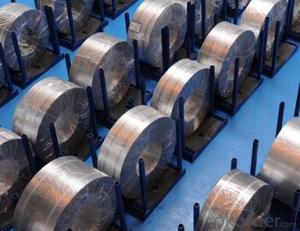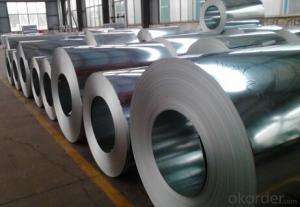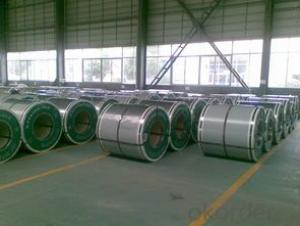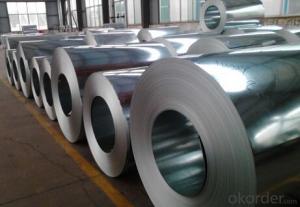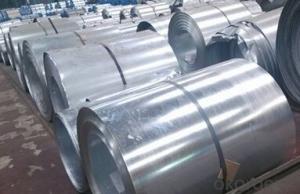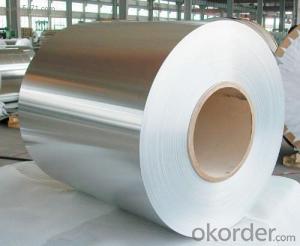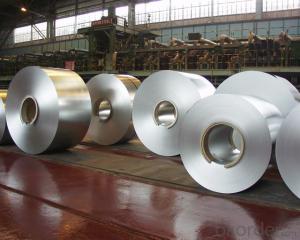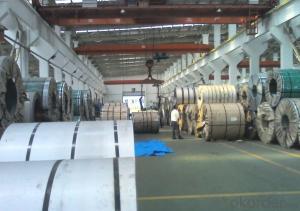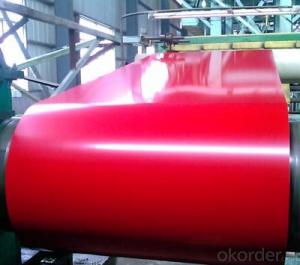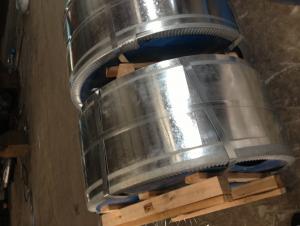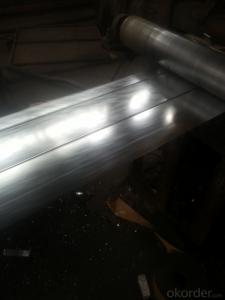Hot-dip Zinc Coating Steel Building Roof Walls Steel Coil ASTM 615-009
- Loading Port:
- Tianjin
- Payment Terms:
- TT OR LC
- Min Order Qty:
- 9999 kg/m²
- Supply Capability:
- 11 kg/m²/month
OKorder Service Pledge
OKorder Financial Service
You Might Also Like
1.Structure of Hot-Dip Galvanized Steel Sheet Description:
Hot-dip galvanized steel coils are available with a pure zinc coating through the hot-dip galvanizing process. It offers the economy, strength and formability of steel combined with the corrosion resistance of zinc. The hot-dip process is the process by which steel gets coated in layers of zinc to protect against rust. It is especially useful for countless outdoor and industrial applications. Production of cold formed corrugated sheets and profiles for roofing, cladding, decking, tiles, sandwich walls, rainwater protective systems, air conditioning duct as well as electrical appliances and engineering.tungsten, carbon and so on. Basically, steel is an iron-carbon alloy that does not undergo eutectic reaction. In contrast,cast iron does undergo eutectic reaction, suddenly solidifying into solid phases at exactly the same temperature. Too little carbon content leaves (pure) iron quite soft, ductile, and weak. Carbon contents higher than those of steel make an alloy, commonly called pig iron, that is brittle (not malleable). While iron alloyed with carbon is called carbon steel, alloy steel is steel to which other alloying elements have been intentionally added to modify the characteristics of steel. Common alloying elements include: manganese, nickel, chromium, molybdenum, boron, titanium, vanadium, tungsten, cobalt, and niobium.[1] Additional elements are also important in steel: phosphorus, sulfur, silicon, and traces of oxygen, nitrogen, and copper.
2.Main Features of the Hot-Dip Galvanized Steel Sheet:
• Excellent process capability
• Smooth and flat surface
• Workability, durability
• Excellent anticorrosive property
• High strength
• Good formability
• Good visual effect
3.Hot-Dip Galvanized Steel Sheet Images
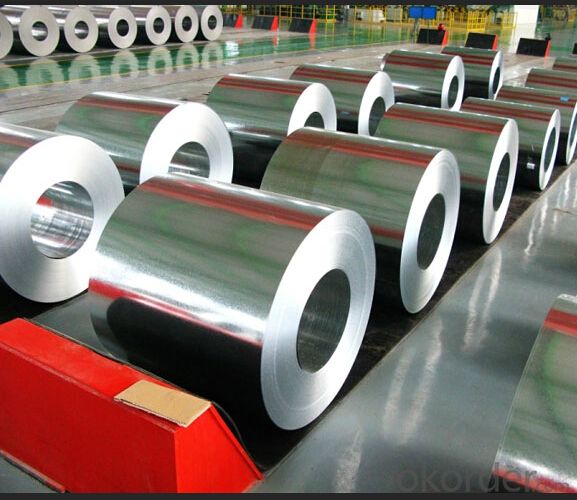
4.Hot-Dip Galvanized Steel Sheet Specification
Standard: ASTM, JIS,EN
Grade: CS, DX51D+Z,SGCC, SS 230~550,S220GD+Z~S550GD+Z, SGC340~SGC570
Thickness: 0.1mm~5mm
Width: max 2000mm
Coil weight:3-12 MT
Coil ID:508/610mm
Surface structure: zero spangle, regular spangle or minimum spangle
Surface treatment: Chromate treatment, Oiled/dry, skinpassed/non-skinpassed
Packing: Standard seaworthy export package
Technology test results:
Processability | Yield strength | Tensile strength | Elongation % | 180°cold-bending |
Common PV | - | 270-500 | - | d=0,intact,no zinc removal |
Mechanical interlocking JY | - | 270-500 | - | d=0,intact,no zinc removal |
Structure JG | >=240 | >=370 | >=18 | d=0,intact,no zinc removal |
Deep drawn SC | - | 270-380 | >=30 | d=0,intact,no zinc removal |
EDDQ SC | - | 270-380 | >=30 | d=0,intact,no zinc removal |
5.FAQ of Hot-Dip Galvanized Steel Sheet
We have organized several common questions for our clients,may help you sincerely:
1.How about your company?
A world class manufacturer & supplier of castings forging in carbon steel and alloy steel,is one of the large-scale professional investment casting production bases in China,consisting of both casting foundry forging and machining factory. Annually more than 8000 tons Precision casting and forging parts are exported to markets in Europe,America and Japan. OEM casting and forging service available according to customer’s requirements.
2.How to guarantee the quality of the products?
We have established the international advanced quality management system,every link from raw material to final product we have strict quality test;We resolutely put an end to unqualified products flowing into the market. At the same time, we will provide necessary follow-up service assurance.
3. How long can we receive the product after purchase?
Usually within thirty working days after receiving buyer’s advance payment or LC. We will arrange the factory manufacturing as soon as possible. The cargo readiness usually takes 15-30 days, but the shipment will depend on the vessel situation.
- Q: Can steel strips be used in electrical or electronic applications?
- Indeed, electrical or electronic applications can incorporate steel strips. Although steel is not commonly utilized as an electrical conductor, it can serve as a structural element or for shielding in specific electrical or electronic devices. Transformers, for instance, frequently employ steel strips to uphold the shape and integrity of the apparatus. Moreover, steel strips may function as a shielding material, safeguarding delicate electronic components against electromagnetic interference. Consequently, although steel strips may not be the foremost option for electrical conductivity, they can contribute significantly in diverse electrical and electronic applications.
- Q: How do steel strips compare to other materials in terms of strength and durability?
- Steel strips are known for their exceptional strength and durability. Compared to other materials, such as aluminum or plastic, steel strips offer superior strength and are more resistant to deformation or breakage under heavy loads or extreme conditions. Additionally, steel strips have a high durability, as they are less prone to corrosion and wear, making them suitable for long-term use in various applications.
- Q: How are steel strips heat treated?
- Steel strips are commonly heat treated through a process called annealing, which involves heating the strips to a specific temperature and then slowly cooling them. This helps to relieve internal stresses and improve the steel's mechanical properties, such as hardness and ductility. Other heat treatment methods, such as quenching and tempering, may also be utilized depending on the desired characteristics of the steel.
- Q: How are steel strips processed for brazing?
- Steel strips are processed for brazing by first cleaning them thoroughly to remove any dirt, oil, or oxidation. Next, the strips are coated with a flux material to promote proper brazing flow and bonding. The coated steel strips are then heated to the appropriate temperature for brazing, and a brazing filler material is applied to the joint area. Finally, the strips are heated again to melt the filler material, which then flows and solidifies to create a strong bond between the steel strips.
- Q: How are steel strips used in the production of automotive parts?
- Due to their strength, durability, and versatility, steel strips are commonly utilized in the manufacturing of automotive parts. These strips are typically crafted from high-quality steel alloys that are specifically engineered to meet the rigorous demands of the automotive industry. One of the main applications of steel strips in the production of automotive parts lies in the fabrication of body panels. These panels, including doors, hoods, fenders, and roofs, require materials that can endure impacts, resist corrosion, and provide structural integrity. Steel strips are an ideal choice for these components since they offer an excellent strength-to-weight ratio, ensuring the safety and performance of the vehicle. In addition, steel strips are also employed in the production of structural components like chassis frames and suspension systems. These parts must be able to withstand heavy loads, endure harsh road conditions, and provide stability. Steel strips provide the necessary strength and rigidity to these components, guaranteeing the overall structural integrity of the vehicle. Moreover, steel strips find use in the production of smaller automotive parts. These include brackets, reinforcements, supports, connectors, and various other components that require high strength and dimensional accuracy. Steel strips can be easily cut, formed, and welded to create intricate shapes and designs, making them a preferred material in the automotive industry. Furthermore, steel strips are often utilized in the manufacturing of safety-related automotive parts such as seatbelt buckles, door latches, and airbag components. These parts necessitate materials that can endure extreme forces and deliver reliable performance in critical situations. Steel strips offer the necessary strength, toughness, and resistance to deformation, ensuring the safety of passengers in the event of accidents. Overall, steel strips play a crucial role in the production of automotive parts by providing strength, durability, and versatility. Their usage in body panels, structural components, smaller parts, and safety-related components contributes to the overall performance, safety, and longevity of vehicles.
- Q: What are the different surface coatings available for steel strips to improve wear resistance?
- There are several surface coatings available for steel strips to enhance their wear resistance. Some common options include metallic coatings like zinc or tin, ceramic coatings such as alumina or zirconia, and organic coatings like polymer-based materials. These coatings form a protective layer on the steel surface, reducing friction and preventing wear and corrosion. The choice of coating depends on the specific application requirements and the level of wear resistance needed.
- Q: How are steel strips used in the railway industry?
- Steel strips are widely used in the railway industry for various purposes. One of the primary applications of steel strips is in the manufacturing of railway tracks. These strips are used to create the rails that form the track structure. The steel strips are typically hot-rolled and shaped into the desired rail profile, providing strength, durability, and stability to the track. Steel strips are also used in the construction of railway bridges and tunnels. They are often employed as reinforcement elements in the concrete structures, increasing their load-bearing capacity and structural integrity. Steel strips can also be used as tie plates, which are placed between the rail and the wooden ties to distribute the load evenly and prevent the rail from sinking into the ties. In addition to track and infrastructure applications, steel strips find their use in the manufacturing of various railway components. These include rail clips, fishplates, and fasteners. Rail clips are used to secure the rails to the sleepers, preventing lateral movement and maintaining the proper alignment of the track. Fishplates, also known as joint bars, are used to connect two rail sections together, ensuring a smooth transition between them. Fasteners, such as bolts and nuts, are utilized to secure the rail components tightly, maintaining the stability and safety of the track. Furthermore, steel strips are also employed in the fabrication of rolling stock components. They are used in the construction of railway wagons and locomotives, forming the structural framework and providing strength and rigidity to the vehicles. Steel strips are also used in the manufacturing of various interior and exterior parts, such as doors, panels, and frames. Overall, steel strips play a crucial role in the railway industry, providing the necessary strength, durability, and stability to the track, infrastructure, and rolling stock components. Their versatility and excellent mechanical properties make them an essential material for ensuring the safe and efficient operation of railways.
- Q: What are the different types of corrosion that affect steel strips?
- There are several types of corrosion that can affect steel strips, including general corrosion, pitting corrosion, crevice corrosion, galvanic corrosion, and stress corrosion cracking.
- Q: How do steel strips contribute to product sustainability in various applications?
- Steel strips contribute to product sustainability in various applications by providing a durable and long-lasting material that can be recycled and reused, reducing the need for virgin materials. They are also lightweight, which helps to reduce transportation emissions. Additionally, steel strips offer high strength and corrosion resistance, resulting in longer product lifecycles and reduced maintenance requirements. Overall, the use of steel strips promotes resource efficiency, reduces waste, and minimizes environmental impact, making it a sustainable choice for a wide range of applications.
- Q: Are steel strips used in the production of furniture?
- Indeed, furniture production commonly relies on the utilization of steel strips. These versatile and durable materials are frequently incorporated as reinforcement or structural elements in the manufacturing of furniture. To enhance strength and stability, steel strips are commonly integrated into the frames of chairs, tables, and various other furniture types. Furthermore, these steel strips can also serve as decorative embellishments or trimmings in furniture designs. In summary, steel strips hold a crucial position in the furniture production process, significantly contributing to the durability and functionality of the final product.
Send your message to us
Hot-dip Zinc Coating Steel Building Roof Walls Steel Coil ASTM 615-009
- Loading Port:
- Tianjin
- Payment Terms:
- TT OR LC
- Min Order Qty:
- 9999 kg/m²
- Supply Capability:
- 11 kg/m²/month
OKorder Service Pledge
OKorder Financial Service
Similar products
Hot products
Hot Searches
Related keywords
